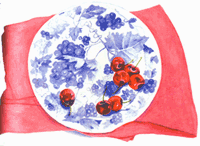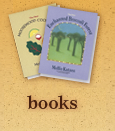Yield: About 6 servings
Preparation Time: 2 hours (15 minutes of work). This includes time for cooking the rice, which can be done in advance.
 Botanically
speaking, wild rice is really an aquatic grass and not a true
member of the rice family. Whatever its classification, with its
dark, mysterious qualities and strong, earthy flavor, wild rice
combines beautifully with aromatic basmati rice and a few touches
of fruit and herbs to make this lovely dish, which can be served at
any temperature and at any time of day. (It actually tastes best
served at room temperature.)
Botanically
speaking, wild rice is really an aquatic grass and not a true
member of the rice family. Whatever its classification, with its
dark, mysterious qualities and strong, earthy flavor, wild rice
combines beautifully with aromatic basmati rice and a few touches
of fruit and herbs to make this lovely dish, which can be served at
any temperature and at any time of day. (It actually tastes best
served at room temperature.)
NOTE: This keeps well for several days, if tightly covered and refrigerated. Just hold off on adding the fresh herbs until shortly before serving, so they won't turn black.
1 medium recipe Pilaf-Style Basmati Rice (recipe follows)
1 teaspoon minced garlic
1 1/4 teaspoons salt
1/2 to 3/4 cup dried sour cherries, halved
1/2 to 3/4 cup dried cranberries
1 to 2 tablespoons fresh lemon juice
2 tablespoons grated orange zest
1 cup orange sections
1/4 cup orange juice
Black pepper to taste
1/4 cup minced fresh chives or scallions
1/4 cup minced fresh mint
OPTIONAL TOPPINGS:
Strips of orange peel
Minced parsley
- Place the wild rice in a medium-sized saucepan and add 2 1/2 cups water. Cover the pan and heat to a boil. Lower the heat to the slowest possible simmer, and cook, covered and undisturbed, until tender. This will take about 1 1/4 to 1 1/2 hours.
- While the wild rice is simmering, prepare the Pilaf-Style Basmati Rice (below).
- When the wild rice is cooked, fluff it thoroughly with a fork to let the steam escape, then add it to the cooked basmati rice, still in its baking pan. Gently stir in the garlic, salt, dried fruit, lemon juice, grated orange zest, about half of the orange sections, and the orange juice. (Fluff the pilaf with a fork as you stir.)
- Add black pepper to taste. Let it stand for at least 30 minutes, to let the flavors mingle.
- Serve at room temperature, or cold. (If you want to serve it warm, just place the covered pan back in a 350ÁF oven for about 20 minutes, or until heated through.) Shortly before serving, stir in the chives or scallions and the mint. Place the reserved orange sections on top, and sprinkle with strips of orange peel and a little minced parsley, if desired.
Preparation time: 25 minutes (white basmati); 55 minutes (brown basmati).
Yield: About 6 cups cooked rice (medium batch); about 9 cups cooked rice (large batch)
NOTE: The actual work time is about 5 to 10 minutes. You can prepare the other pilaf ingredients while the rice cooks.
 Basmati rice is my favorite choice for pilafs,
because it has a fantastic nutty taste, an excellent texture, and
great versatility. It is an aromatic rice, originally from Northern
India and Pakistan, but is now grown in the United States as well.
The word "basmati" means "queen of fragrance", and the minute you
drop these grains into a potful of boiling water and take a whiff,
you'll know why.
Basmati rice is my favorite choice for pilafs,
because it has a fantastic nutty taste, an excellent texture, and
great versatility. It is an aromatic rice, originally from Northern
India and Pakistan, but is now grown in the United States as well.
The word "basmati" means "queen of fragrance", and the minute you
drop these grains into a potful of boiling water and take a whiff,
you'll know why.
This is the best way I have found to cook basmati rice for pilafs: First you boil it in a large quantity of salted water until it is mostly cooked, then you drain the rice, transfer it to a shallow pan, cover tightly, and bake it until done. This takes about the same amount of time as the old-fashioned stovetop method, but more reliably produces perfectly separate, fluffy rice, ready to combine with whatever additional ingredients are called for. (Several pilaf recipes follow.) Two additional benefits: a) You are spared having to worry about proportions of rice to water; and b) after the rice is done, you can leave it right where it is, directly add the other pilaf ingredients, and reheat as necessary in the same pan.
NOTE: Use this method as the springboard for the pilaf recipes that follow. (You can also make plain basmati rice this way, or just cook it as you normally would.)
These instructions will work for any amount of basmati rice, white or brown.
NOTE: For a medium recipe, use 2 cups uncooked rice; for a large recipe, use 3 cups uncooked rice.
1 tablespoon salt
2 or 3 cups uncooked basmati rice, white or brown
1 tablespoon vegetable oil or melted butter
- Preheat the oven to 350°F. Put the water and salt in a large saucepan, and bring to a rolling boil. Meanwhile, place the rice in a strainer and rinse several times under cold running water.
- Add the rice to the boiling water and let it boil rapidly, 10 minutes for white; 30 for brown , or until the rice is just tender to the bite–in other words, almost done. Drain the rice in a colander over the sink, and rinse with warm running water.
- Brush the oil or melted butter over the bottom surface of a 9 X13-inch pan (or a 10 X 13-inch pan, if you have one, for the large batch), and spread out the rice in an even layer. Tightly cover the pan with foil, and bake for 15 minutes (25 minutes for brown basmati), or until the rice is done to your liking.
- Carefully stir in whatever special ingredients the pilaf recipe calls for, and cover the pan tightly until serving time. Serve hot, warm, or at room temperature. (Reheat in a 350°F oven to the desired temperature, if necessary.)






